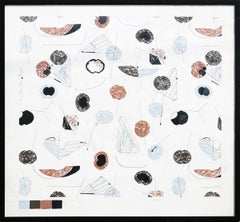MIchail Grobman
Gouache and watercolor on paper
Hand signed Lower Left and Dated 1964.
Described inn Cyrillic Russian verso.
Dimensions: L:13.25" W: 11.75".
Michail Grobman (Russian: Михаил Гробман, Hebrew: מיכאיל גרובמן, born 1939) is an artist and a poet working in Israel and Russia. He is father to Hollywood producer Lati Grobman and Israeli architect Yasha Jacob Grobman.
Biography
1939 – Born in Moscow.
1960s – Active member of The Second Russian Avant-Garde movement in the Soviet Union.
1967 – Member of Moscow Artists Union.
1971 – Emigrates to Israel and settles in Jerusalem.
1975 – Founded the Leviathan group and art periodical (in Russian).
Since 1983, he lives and works mainly in Tel Aviv.
Awards
In 2001, Grobman was a co-recipient of the Dizengoff Prize for Painting.
Solo exhibitions
2007 – Last Skies, Loushy & Peter Art & Projects, Tel Aviv (cat. text: Marc Scheps)
2006 – Creation From Chaos to Cosmos, Bar-David Museum of Fine Art and Judaica, Kibbutz Baram (cat. text: Sorin Heller)
2002 – The Last Sky, installation, Tsveta Zuzoritch pavilion, Belgrad (cat. text: Irina Subotitch)
1999 – Mikhail Grobman: Works 1960–1998, The State Russian Museum, St. Petersburg (cat. texts: Evgeniya Petrova, Marc Scheps, Lola Kantor-Kazovsky, Michail German)
Michail Grobman was born in Moscow. He grew up writing poetry, essays and literary prose. In the 1960s, he was active in the Second Russian Avant-garde movement in the Soviet Union. In 1971, he immigrated to Israel. In 1975, he established the Leviathan school together with Avraham Ofek and Shmuel Ackerman, seeking to combine symbolism, metaphysics and Judaism in an all-inclusive “national style.”
Grobman’s lithograph work employs images and symbols from Jewish mysticism and Kabbalah. His paintings incorporate texts in Russian and Hebrew. In addition to his artistic endeavors, he writes about art and aesthetics. The group combined conceptual art and "land art" with Jewish symbolism. Of the three of them Avraham Ofek had the deepest interest in sculpture and its relationship to religious symbolism and images. In one series of his works Ofek used mirrors to project Hebrew letters, words with religious or cabbalistic significance, and other images onto soil or man-made structures. In his work "Letters of Light" (1979), for example, the letters were projected onto people and fabrics and the soil of the Judean Desert. In another work Ofek screened the words "America", "Africa", and "Green card" on the walls of the Tel Hai courtyard during a symposium on sculpture
Part of the generation of emigre Russian artists, many Jewish, that included Yuri Kuper, Komar and Melamid, Eduard Steinberg, Erik Bulatov, Viktor Pivovarov, Vladimir Yankilevsky, Ilya Kabakov and Grisha Bruskin.
Date of Birth: 1939, Moscow
1960s Active member of The Second Russian Avant Garde
1967 Member of the Moscow Painters Association
1971 Immigrated to Israel and settled in Jerusalem
1975 Founded the Leviathan group and art periodical (in Russian)
Since 1983 Lives and works in Tel Aviv
.
Selected Solo Exhibitions:
2002 Pavilion Zveta Zuzovich, "The Last Sky", Belgrad (cat: Irena Subotitch)
1999 The State Russian Museum, ST. Petersburg
1998 "Picture = Symbol + Concept", Herzliya Museum of Art, Herzliya
1995 "Password and Image", University Gallery, Haifa University
1990 Tova Osman Gallery, Tel Aviv
1989 "The Beautiful Sixties in Moscow", The Genia Schreiber University Art Gallery, Tel Aviv University (with llya Kabakov; cat. text: Mordechai Omer]
Spertus Museum, Chicago
Beit Rami and Uri Nechushtan, Ashdot Yaacov (leaflet)
1972 Nora Gallery, Jerusalem 1973 - Negev Museum, Beer Sheva
1971 Tel Aviv Museum of Art (cat. text: Haim Gamzu)
1966 Mos-lng-Projekt, Moscow
1965 Artist's House, Moscow
Energy Institute, Moscow
History Institute, Moscow
Usti-nad-Orlicy Theatre,Czechoslovakia (leaflet text: Dushan Konetchni)
1959 Mukhina Art Institute, Leningrad
.
Selected Group Exhibitions:
2003 "Yes do yourself...", Regeneration of Judaism in Israeli art, Zman Omanut Tel Aviv (cat: Gideon Ofrat)
1999 "Russian post-war avantgarde", The Trajsman Collection in the State Russian Museum, St. Petersburg Tretjakov National Gallery, Moscow (cat. text: Yevgenij Barabanov,
John Bolt...


